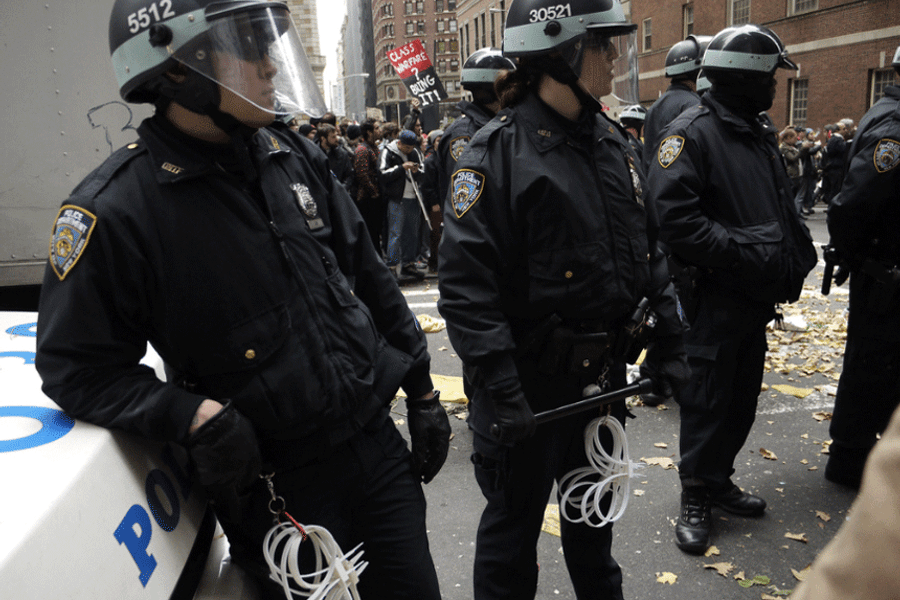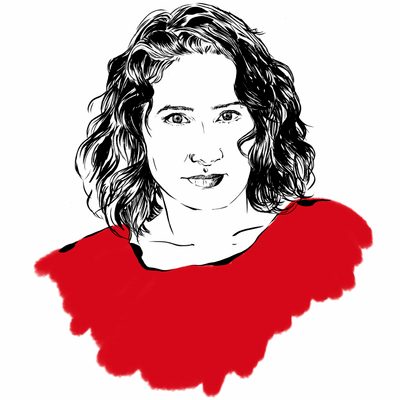Post-Occupy, #myNYPD Makes New York’s Blood Boil
As Occupier Cecily McMillan stands trial, the city’s 99% rediscovers its anger toward the NYPD.
Sarah Jaffe

On Tuesday, April 22, the New York City Police Department had a very bad idea. Someone at the NYPD decided that the department could be doing better with its social media engagement and asked people to tweet photos of themselves with NYPD officers using the hashtag #myNYPD.
Perhaps predictably, the photos were not what they wanted. Activists quickly flooded the hashtag with photos of violent arrests, many of them from the days of Occupy Wall Street. The result was that the hashtag trended, with activists around the world joining in, prompting spinoff hashtags and even garnering the notice of the tabloids and the New York Times.
It seems the NYPD doesn’t quite understand the depth of the city’s anger toward the department, even with a new (well, new-old) commissioner under a new mayor who ran a campaign against stop-and-frisk. Mayor Bill de Blasio even went so far as to declare: “Now that we’ve moved away from that broken policy, and we’ve settled the lawsuits, and we are changing the dynamics on the ground between police and community, I think the average officer’s having a much better experience.”
The average officer may be faring better, but a whole lot of New Yorkers out there still aren’t.
On April 23, the day after #myNYPD hit Twitter, I spent the afternoon in a criminal courtroom in Lower Manhattan listening to some reasons why New Yorkers don’t feel safer with police around. Cecily McMillan, a graduate student and Occupy Wall Street organizer, sat in the defendant’s chair, scribbling notes to her attorneys on hot pink note-paper. McMillan was arrested on March 17, 2012 — the six-month anniversary of Occupy — when Zuccotti Park was cleared of protesters who had briefly taken back the park late in the night. She is accused of having elbowed NYPD Officer Grantley Bovell in the face during the course of her arrest. McMillan faces felony charges of assault on an officer; if convicted, she could serve seven years. The trial began April 11, and is expected to last about three weeks.
McMillan contends that Officer Bovell grabbed her breast from behind and she reacted instinctively, elbowing backwards in reaction to what she considered an assault.
I never met Cecily McMillan at Occupy Wall Street and I didn’t meet her on Wednesday. I was unable to speak with McMillan’s lawyers, who are under a gag order from the judge and prohibited from talking to reporters. Instead, I simply sat in the audience, one of many there to observe.
And I didn’t see McMillan’s arrest. But like many people who’d been around Occupy Wall Street, I stopped by the park that night after drinks with friends in the area. The park was ringed with police, but for the time I was there, the atmosphere was celebratory if tense. Old friends chatted; bagpipers were playing. At one point a small handful of police officers charged into the park and pulled down a tarp draped between two trees, but there were no arrests, and after a while, I went home. Looking back at my Alternet report on the event, I note I told friends: “I just want to get out … before they stomp on someone again.” The park was evicted of Occupiers while I was somewhere underground on a 2 train.
What happened after I left was captured on cell phone video and livestreams. A video of McMillan apparently having a seizure after her struggle with the officer was disallowed from the courtroom the morning of April 23, according to Wall Street Journal reporter Nick Pinto, who’s been covering the trial daily. But as the New York Times described the scene back in March 2012:
At one point, a woman who appeared to be suffering from seizures flopped on the ground in handcuffs as bystanders shouted for the police to remove the cuffs and provide medical attention. For several minutes the woman lay on the ground as onlookers made increasingly agonized demands until an ambulance arrived and the woman was placed inside.
Also disallowed from the trial was Officer Bovell’s record; he has faced prior allegations of brutality, and is currently being sued by another Occupier, Austin Guest, who says Bovell dragged him down the aisle of a bus while “intentionally banging his head on each seat.” The NYPD has paid out thousands to settle claims by Occupiers. That includes a $55,000 settlement announced Thursday, April 24 [video at the link] to be paid to Josh Boss, who was livestreaming an Occupy march when he was thrown to the ground and kneed by Chief Thomas Purtell, who was at the time the commanding officer of the Manhattan South Patrol Division. Also among the final tally is $82,500 to Shawn Schrader, who goes by Shawn Carrie, over three separate violent arrests. A joint report from NYU’s Global Justice Clinic and Fordham’s Walter Leitner International Human Rights Clinic [PDF] found that the police’s treatment of Occupy included “frequent alleged incidents of unnecessary and excessive police use of force against protesters, bystanders, journalists, and legal observers; constant obstructions of media freedoms, including arrests of journalists; unjustified and sometimes violent closure of public space, dispersal of peaceful assemblies, and corralling and trapping protesters en masse.”
Yet Cecily McMillan, not Officer Bovell, is on trial, and the judge ruled that the officer’s record is irrelevant.
When testimony began at the trial that afternoon, Officer Linda Waring was on the stand. Waring took custody of McMillan after she was sent to the hospital, to jail and eventually to Central Booking. McMillan’s lawyer, Martin Stolar, asked Waring repeatedly whether she saw injuries to McMillan, what her complaints were at the hospital, how she reacted to the news that she was being charged with assaulting an officer. Waring responded that McMillan seemed surprised, that she didn’t know why she’d be charged with such a thing. When Stolar asked her opinion of the Occupy protests, the judge disallowed every question except: “Were the protesters smelly?” and “Was it personal for you?””— to which Waring replied, “No, it’s business.”
What they don’t tell you about court, what the courtroom dramas don’t show, is how deadly boring it is. At one point during the testimony of the District Attorney’s Office forensic video expert, explaining a video that allegedly depicts McMillan’s altercation with Officer Bovell, at least one juror appeared to actually fall asleep. And yet as you sit there, watching, listening to the same question being asked over and over, you remember that someone’s life is on the line, that the third repetition of a blurry YouTube video from the night of March 17 could make the difference between conviction and acquittal. The video expert — in his three-piece suit and his smiles at the jury box, pointing at a green blur on a screen— becomes less boring when you remember that. You begin to sift through the hundreds of answers, looking for something that seems relevant. The fact that struck me was that the video was, according to the expert’s testimony, downloaded from YouTube on the morning of March 18, 2012, just hours after McMillan’s arrest. How quickly did the prosecution begin preparing its case? But those individual bits of information don’t add up to anything on their own. You have to go every day for them to make a story, and even then you have to decide which bits fit into the story you believe is true.
Cecily McMillan’s story fits into a bigger story about the NYPD and the city that I’ve been following for a while. Like many white women in New York, my first experience getting pushed around by the NYPD was at Occupy Wall Street. As a reporter, I would attempt to ask questions of officers and be rebuffed, sometimes physically; in a crowd, I looked like other protester and was shoved around accordingly. I witnessed plenty of violent arrests, including those of friends and fellow reporters. I tweeted a few photos of those incidents on the #myNYPD hashtag.
These days, protest arrests are scarce and attention has faded from the NYPD’s repressive tactics; some seem to consider the matter of police abuses closed with the reforms passed by City Council and imposed by a court of law. Yet protest arrests have largely faded because Occupy no longer holds parks and takes streets — and out in residential neighborhoods, there are no livestreamers and few reporters. I rarely go a week without seeing police detaining someone, usually a young man of color.
Of course, it is important to cover Cecily McMillan’s case, and to speak up for the rights of people everywhere to peaceably assemble in protest. It is equally important not to forget that there are people all over New York whose trials are not getting this kind of attention, or who do not go to trial at all because they have no help, no support, no one to stand by them while they refuse a plea bargain in an attempt to keep felony charges off their records. There were only two reporters who seemed to have stuck around for all of McMillan’s multi-week trial. How many reporters cover the courthouses for everyday arrests?
Cecily McMillan’s case can’t just be about her, about whether she’s a nice girl or a pacifist or not. It has to be — as the #myNYPD hashtag reminded us with its seemingly endless stream of violent photographs— about a police force that has gotten away with too much for too long and has not changed nearly enough.
Sarah Jaffe is a writer and reporter living in New Orleans and on the road. She is the author of Work Won’t Love You Back: How Devotion To Our Jobs Keeps Us Exploited, Exhausted, and Alone; Necessary Trouble: Americans in Revolt, and her latest book is From the Ashes: Grief and Revolution in a World on Fire, all from Bold Type Books. Her journalism covers the politics of power, from the workplace to the streets, and her writing has been published in The Nation, The Washington Post, The Guardian, The New Republic, the New York Review of Books, and many other outlets. She is a columnist at The Progressive and In These Times. She also co-hosts the Belabored podcast, with Michelle Chen, covering today’s labor movement, and Heart Reacts, with Craig Gent, an advice podcast for the collapse of late capitalism. Sarah has been a waitress, a bicycle mechanic, and a social media consultant, cleaned up trash and scooped ice cream and explained Soviet communism to middle schoolers. Journalism pays better than some of these. You can follow her on Twitter @sarahljaffe.








